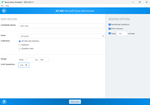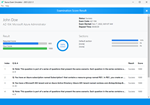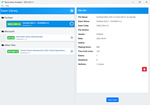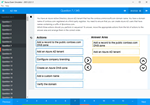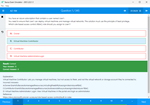Download BCS Foundation Certificate in Business Analysis V4.0.PC-BA-FBA-20.VCEplus.2025-02-25.16q.tqb
| Vendor: | BCS |
| Exam Code: | PC-BA-FBA-20 |
| Exam Name: | BCS Foundation Certificate in Business Analysis V4.0 |
| Date: | Feb 25, 2025 |
| File Size: | 104 KB |
How to open TQB files?
Files with TQB (Taurus Question Bank) extension can be opened by Taurus Exam Studio.
Purchase
Coupon: TAURUSSIM_20OFF
Discount: 20%
Demo Questions
Question 1
A report has been created into improving the scheduling of physio appointments at a major hospital An extract reads
'The scheduling team have a strong set of skills that will not need to be updated However, the team should be split into two. one dealing with inpatients and one with outpatients The introduction of a new telephony software and an online booking system will also require changes to the process'
How might these changes be BEST presented to communicate with the scheduling team'?
- Business Process Model
- Business Activity Model
- POPIT
- Prototype
Correct answer: D
Explanation:
To determine the best way to present the changes to the scheduling team, we need to consider the nature of the information being communicated and the audience (the scheduling team). The extract describes changes to processes, roles, and systems, which are best represented visually to ensure clarity and understanding.Key Considerations:Business Process Model (BPM): A BPM is a visual representation of the steps in a process. It is particularly useful for communicating changes to workflows, roles, and responsibilities. Since the extract discusses splitting the scheduling team into two groups and introducing new software and processes, a BPM would effectively illustrate how these changes impact the workflow.Business Activity Model (BAM): A BAM focuses on high-level activities and their logical dependencies, often used in strategic planning. However, it is less detailed than a BPM and may not adequately capture the specific changes to scheduling processes.POPIT (People, Organization, Process, Information, Technology): POPIT is a framework for analyzing business change across multiple dimensions. While it provides a holistic view, it is not a presentation tool and would not be the best choice for directly communicating the changes to the scheduling team.Prototype: A prototype is typically used to demonstrate the functionality of a system or software. While the introduction of telephony software and an online booking system could involve prototyping, this option does not address the need to communicate process and role changes.Evaluation of Each Option:A . Business Process Model: A BPM is ideal for illustrating the changes to the scheduling process, including the split into inpatient and outpatient teams and the integration of new software. It provides a clear, step-by-step visual representation that the scheduling team can easily understand. Conclusion: This is the best option .B . Business Activity Model: While a BAM could provide a high-level overview of the changes, it lacks the detail needed to explain specific process adjustments. Conclusion: This is not the best option .C . POPIT: POPIT is a framework for analysis, not a communication tool. It would not effectively convey the changes to the scheduling team. Conclusion: This is not the best option .D . Prototype: Prototyping is relevant for demonstrating software functionality but does not address the need to communicate process and role changes. Conclusion: This is not the best option .Final Recommendation:The changes should be presented using a Business Process Model , as it effectively communicates the revised workflows and roles to the scheduling team. To determine the best way to present the changes to the scheduling team, we need to consider the nature of the information being communicated and the audience (the scheduling team). The extract describes changes to processes, roles, and systems, which are best represented visually to ensure clarity and understanding.
Key Considerations:
Business Process Model (BPM): A BPM is a visual representation of the steps in a process. It is particularly useful for communicating changes to workflows, roles, and responsibilities. Since the extract discusses splitting the scheduling team into two groups and introducing new software and processes, a BPM would effectively illustrate how these changes impact the workflow.
Business Activity Model (BAM): A BAM focuses on high-level activities and their logical dependencies, often used in strategic planning. However, it is less detailed than a BPM and may not adequately capture the specific changes to scheduling processes.
POPIT (People, Organization, Process, Information, Technology): POPIT is a framework for analyzing business change across multiple dimensions. While it provides a holistic view, it is not a presentation tool and would not be the best choice for directly communicating the changes to the scheduling team.
Prototype: A prototype is typically used to demonstrate the functionality of a system or software. While the introduction of telephony software and an online booking system could involve prototyping, this option does not address the need to communicate process and role changes.
Evaluation of Each Option:
A . Business Process Model: A BPM is ideal for illustrating the changes to the scheduling process, including the split into inpatient and outpatient teams and the integration of new software. It provides a clear, step-by-step visual representation that the scheduling team can easily understand. Conclusion: This is the best option .
B . Business Activity Model: While a BAM could provide a high-level overview of the changes, it lacks the detail needed to explain specific process adjustments. Conclusion: This is not the best option .
C . POPIT: POPIT is a framework for analysis, not a communication tool. It would not effectively convey the changes to the scheduling team. Conclusion: This is not the best option .
D . Prototype: Prototyping is relevant for demonstrating software functionality but does not address the need to communicate process and role changes. Conclusion: This is not the best option .
Final Recommendation:
The changes should be presented using a Business Process Model , as it effectively communicates the revised workflows and roles to the scheduling team.
Question 2
A company is reviewing its critical success factors and key performance indicators So far. it has key performance indicators for the following
The time to deliver orders for products Consumer satisfaction with products Wastage in product production The qualifications of production employees
Which area of Kaplan and Norton's balanced business scorecard has NOT been considered?
- Learning and growth
- Internal business process
- Customer
- Financial
Correct answer: D
Explanation:
Kaplan and Norton's Balanced Business Scorecard is a strategic framework that evaluates organizational performance across four key perspectives: Financial, Customer, Internal Business Processes, and Learning and Growth.To determine which area has not been considered, we need to map the provided KPIs to these perspectives.Mapping the KPIs:The time to deliver orders for products: This relates to operational efficiency and falls under the Internal Business Process perspective.Consumer satisfaction with products: This directly measures customer experience and falls under the Customer perspective.Wastage in product production: This also relates to operational efficiency and falls under the Internal Business Process perspective.The qualifications of production employees: This measures employee capabilities and development, falling under the Learning and Growth perspective.Evaluating Each Perspective:Financial: None of the provided KPIs address financial performance, such as revenue, profitability, or cost management. Conclusion: This perspective has not been considered .Customer: Consumer satisfaction with products is a clear indicator of the Customer perspective. Conclusion: This perspective has been considered.Internal Business Process: Both 'time to deliver orders' and 'wastage in production' relate to internal processes. Conclusion: This perspective has been considered.Learning and Growth: The qualifications of production employees indicate employee development, which aligns with this perspective. Conclusion: This perspective has been considered.Final Recommendation:The Financial perspective has not been considered in the company's KPIs. Kaplan and Norton's Balanced Business Scorecard is a strategic framework that evaluates organizational performance across four key perspectives: Financial, Customer, Internal Business Processes, and Learning and Growth.
To determine which area has not been considered, we need to map the provided KPIs to these perspectives.
Mapping the KPIs:
The time to deliver orders for products: This relates to operational efficiency and falls under the Internal Business Process perspective.
Consumer satisfaction with products: This directly measures customer experience and falls under the Customer perspective.
Wastage in product production: This also relates to operational efficiency and falls under the Internal Business Process perspective.
The qualifications of production employees: This measures employee capabilities and development, falling under the Learning and Growth perspective.
Evaluating Each Perspective:
Financial: None of the provided KPIs address financial performance, such as revenue, profitability, or cost management. Conclusion: This perspective has not been considered .
Customer: Consumer satisfaction with products is a clear indicator of the Customer perspective. Conclusion: This perspective has been considered.
Internal Business Process: Both 'time to deliver orders' and 'wastage in production' relate to internal processes. Conclusion: This perspective has been considered.
Learning and Growth: The qualifications of production employees indicate employee development, which aligns with this perspective. Conclusion: This perspective has been considered.
Final Recommendation:
The Financial perspective has not been considered in the company's KPIs.
Question 3
AlpmeTrails is a company that specialises in offering tailored walking holidays The company was set up by two people, who each own 50% of the business AlpineTrails books hotels, transport and equipment to create bespoke holidays for AlpineTrails customers.
An agreement was recently reached with WalkNation. a national walking organisation, for AlpineTrails to provide a number of special holidays for its members These will be branded as WalkNation Holidays AlpineTrails will be responsible for organising the holidays but WalkNation will undertake the marketing and booking of these special holidays for its members
As well as customers, which THREE stakeholder groups are represented in this scenario?
- Owner
- Partner
- Supplier
- Manager.
- Competitor
Correct answer: ABC
Explanation:
To identify the stakeholder groups represented in the scenario, we need to analyze the relationships and roles described:Stakeholder Groups in the Scenario:Owner: The two founders of AlpineTrails, who each own 50% of the business, are clearly stakeholders as owners. They have a vested interest in the success of the business and its partnerships.Partner: WalkNation is described as a partner organization that collaborates with AlpineTrails to offer special holidays for its members. This partnership involves shared responsibilities (marketing and booking by WalkNation, holiday organization by AlpineTrails).Supplier: AlpineTrails books hotels, transport, and equipment to create bespoke holidays. These entities (hotels, transport providers, equipment suppliers) are suppliers to AlpineTrails and play a critical role in delivering the holidays.Manager: While managers may exist within AlpineTrails, they are not explicitly mentioned in the scenario. Therefore, this group is not represented.Competitor: Competitors are not mentioned or implied in the scenario, so this group is not represented.Evaluation of Each Option:A . Owner: The two founders of AlpineTrails are explicitly described as owners. Conclusion: This is a relevant stakeholder group .B . Partner: WalkNation is explicitly described as a partner. Conclusion: This is a relevant stakeholder group .C . Supplier: Hotels, transport, and equipment providers are implicitly described as suppliers. Conclusion: This is a relevant stakeholder group .D . Manager: Managers are not explicitly mentioned in the scenario. Conclusion: This is not a relevant stakeholder group .E . Competitor: Competitors are not mentioned or implied in the scenario. Conclusion: This is not a relevant stakeholder group . To identify the stakeholder groups represented in the scenario, we need to analyze the relationships and roles described:
Stakeholder Groups in the Scenario:
Owner: The two founders of AlpineTrails, who each own 50% of the business, are clearly stakeholders as owners. They have a vested interest in the success of the business and its partnerships.
Partner: WalkNation is described as a partner organization that collaborates with AlpineTrails to offer special holidays for its members. This partnership involves shared responsibilities (marketing and booking by WalkNation, holiday organization by AlpineTrails).
Supplier: AlpineTrails books hotels, transport, and equipment to create bespoke holidays. These entities (hotels, transport providers, equipment suppliers) are suppliers to AlpineTrails and play a critical role in delivering the holidays.
Manager: While managers may exist within AlpineTrails, they are not explicitly mentioned in the scenario. Therefore, this group is not represented.
Competitor: Competitors are not mentioned or implied in the scenario, so this group is not represented.
Evaluation of Each Option:
A . Owner: The two founders of AlpineTrails are explicitly described as owners. Conclusion: This is a relevant stakeholder group .
B . Partner: WalkNation is explicitly described as a partner. Conclusion: This is a relevant stakeholder group .
C . Supplier: Hotels, transport, and equipment providers are implicitly described as suppliers. Conclusion: This is a relevant stakeholder group .
D . Manager: Managers are not explicitly mentioned in the scenario. Conclusion: This is not a relevant stakeholder group .
E . Competitor: Competitors are not mentioned or implied in the scenario. Conclusion: This is not a relevant stakeholder group .
Question 4
The management of a chain of hotels has decided that one of its critical success factors (CSF) is to 'provide excellent customer service' The below measures have been suggested.
Which THREE of these are appropriate key performance indicators (KPIs) for the CSF 'provide excellent customer service'?
- The number of customers who make use of their in-room mini bar
- The percentage of customers who use the leisure facilities
- The number of customers who complain.
- The percentage of customers who join the hotel loyalty scheme
- The percentage of customers who return
Correct answer: CDE
Explanation:
To determine which measures are appropriate Key Performance Indicators (KPIs) for the Critical Success Factor (CSF) 'provide excellent customer service,' we must first understand the relationship between CSFs and KPIs:Critical Success Factors (CSFs): These are the essential areas or activities that an organization must excel at to achieve its goals. In this case, 'provide excellent customer service' is a CSF.Key Performance Indicators (KPIs): These are measurable metrics used to evaluate progress toward achieving a CSF. KPIs should directly align with the CSF and provide actionable insights.Now, let's evaluate each option to determine whether it is an appropriate KPI for the CSF 'provide excellent customer service':A . The number of customers who make use of their in-room mini barThis measure tracks customer behavior related to a specific hotel amenity (the mini bar). While it may indicate customer satisfaction with the room's offerings, it does not directly measure the quality of customer service.Conclusion: This is not an appropriate KPI for the CSF 'provide excellent customer service.'B . The percentage of customers who use the leisure facilitiesThis measure tracks how many customers utilize the hotel's leisure facilities (e.g., gym, pool, spa). While it may reflect customer engagement with the hotel's amenities, it does not directly assess the quality of customer service. Conclusion: This is not an appropriate KPI for the CSF 'provide excellent customer service.'C . The number of customers who complainCustomer complaints are a direct indicator of dissatisfaction and can highlight areas where customer service needs improvement. A high number of complaints suggests poor customer service, while a low number indicates better service quality.This measure is closely aligned with the CSF 'provide excellent customer service' because it provides actionable feedback on service performance.Conclusion: This is an appropriate KPI for the CSF.D . The percentage of customers who join the hotel loyalty schemeCustomers are more likely to join a loyalty scheme if they have had a positive experience with the hotel, including excellent customer service. This measure reflects customer satisfaction and loyalty, which are outcomes ofgood service.Conclusion: This is an appropriate KPI for the CSF.E . The percentage of customers who returnRepeat customers are a strong indicator of customer satisfaction and loyalty, which are directly influenced by the quality of customer service. If customers return to the hotel, it suggests they were satisfied with their previousexperience, including the service they received.Conclusion: This is an appropriate KPI for the CSF. To determine which measures are appropriate Key Performance Indicators (KPIs) for the Critical Success Factor (CSF) 'provide excellent customer service,' we must first understand the relationship between CSFs and KPIs:
Critical Success Factors (CSFs): These are the essential areas or activities that an organization must excel at to achieve its goals. In this case, 'provide excellent customer service' is a CSF.
Key Performance Indicators (KPIs): These are measurable metrics used to evaluate progress toward achieving a CSF. KPIs should directly align with the CSF and provide actionable insights.
Now, let's evaluate each option to determine whether it is an appropriate KPI for the CSF 'provide excellent customer service':
A . The number of customers who make use of their in-room mini bar
This measure tracks customer behavior related to a specific hotel amenity (the mini bar). While it may indicate customer satisfaction with the room's offerings, it does not directly measure the quality of customer service.
Conclusion: This is not an appropriate KPI for the CSF 'provide excellent customer service.'
B . The percentage of customers who use the leisure facilities
This measure tracks how many customers utilize the hotel's leisure facilities (e.g., gym, pool, spa). While it may reflect customer engagement with the hotel's amenities, it does not directly assess the quality of customer service.
Conclusion: This is not an appropriate KPI for the CSF 'provide excellent customer service.'
C . The number of customers who complain
Customer complaints are a direct indicator of dissatisfaction and can highlight areas where customer service needs improvement. A high number of complaints suggests poor customer service, while a low number indicates better service quality.
This measure is closely aligned with the CSF 'provide excellent customer service' because it provides actionable feedback on service performance.
Conclusion: This is an appropriate KPI for the CSF.
D . The percentage of customers who join the hotel loyalty scheme
Customers are more likely to join a loyalty scheme if they have had a positive experience with the hotel, including excellent customer service. This measure reflects customer satisfaction and loyalty, which are outcomes of
good service.
Conclusion: This is an appropriate KPI for the CSF.
E . The percentage of customers who return
Repeat customers are a strong indicator of customer satisfaction and loyalty, which are directly influenced by the quality of customer service. If customers return to the hotel, it suggests they were satisfied with their previous
experience, including the service they received.
Conclusion: This is an appropriate KPI for the CSF.
Question 5
Which variant of the business analyst role needs to think innovatively, embrace the pace of change and seek ways to exploit emerging technologies?
- Enterprise business analyst.
- Digital business analyst.
- Project business analyst.
- Test business analyst.
Correct answer: B
Explanation:
The digital business analyst role focuses on leveraging technology to drive innovation and transformation. This variant of the business analyst role requires creative thinking, adaptability to rapid change, and the ability to exploit emerging technologies.Key Characteristics of Business Analyst Roles:Enterprise Business Analyst: Focuses on aligning business strategies and objectives across the organization.Digital Business Analyst: Emphasizes innovation, digital transformation, and the adoption of emerging technologies.Project Business Analyst: Works within project teams to define and deliver specific solutions.Test Business Analyst: Specializes in ensuring requirements are met through testing and quality assurance.Evaluation of Each Option:A . Enterprise business analyst: While enterprise BAs focus on strategic alignment, they do not specifically emphasize innovation or emerging technologies. Conclusion: This is not correct .B . Digital business analyst: This role explicitly involves thinking innovatively, embracing change, and leveraging emerging technologies. Conclusion: This is correct .C . Project business analyst: Project BAs focus on delivering specific solutions rather than driving innovation or digital transformation. Conclusion: This is not correct .D . Test business analyst: Test BAs focus on validation and quality assurance, not innovation or technology adoption. Conclusion: This is not correct .Final Recommendation:The variant of the business analyst role that needs to think innovatively and embrace change is: B . Digital business analyst. The digital business analyst role focuses on leveraging technology to drive innovation and transformation. This variant of the business analyst role requires creative thinking, adaptability to rapid change, and the ability to exploit emerging technologies.
Key Characteristics of Business Analyst Roles:
Enterprise Business Analyst: Focuses on aligning business strategies and objectives across the organization.
Digital Business Analyst: Emphasizes innovation, digital transformation, and the adoption of emerging technologies.
Project Business Analyst: Works within project teams to define and deliver specific solutions.
Test Business Analyst: Specializes in ensuring requirements are met through testing and quality assurance.
Evaluation of Each Option:
A . Enterprise business analyst: While enterprise BAs focus on strategic alignment, they do not specifically emphasize innovation or emerging technologies. Conclusion: This is not correct .
B . Digital business analyst: This role explicitly involves thinking innovatively, embracing change, and leveraging emerging technologies. Conclusion: This is correct .
C . Project business analyst: Project BAs focus on delivering specific solutions rather than driving innovation or digital transformation. Conclusion: This is not correct .
D . Test business analyst: Test BAs focus on validation and quality assurance, not innovation or technology adoption. Conclusion: This is not correct .
Final Recommendation:
The variant of the business analyst role that needs to think innovatively and embrace change is: B . Digital business analyst.
Question 6
Which of the following is a KEY principle of Business Analysis?
- Present options not solutions.
- Understand the symptoms of the problem being defined.
- Focus on requirements definition only.
- Integrate IT changes together with project requirements to improve efficiency.
Correct answer: A
Explanation:
One of the key principles of business analysis is to present stakeholders with options rather than prescribing a single solution. This approach ensures that stakeholders can make informed decisions based on their priorities and constraints.Key Principles of Business Analysis:Present Options Not Solutions: Business analysts should provide multiple viable options, allowing stakeholders to choose the best course of action.Understand Symptoms: While understanding symptoms is important, it is part of problem analysis, not a key principle.Focus on Requirements Definition Only: Business analysis encompasses more than just defining requirements; it includes understanding problems, analyzing options, and ensuring value delivery.Integrate IT Changes: While integrating IT changes is valuable, it is not a universal principle of business analysis.Evaluation of Each Option:A . Present options not solutions: This is a fundamental principle of business analysis, emphasizing stakeholder choice. Conclusion: This is correct .B . Understand the symptoms of the problem being defined: Understanding symptoms is part of problem analysis but not a standalone principle. Conclusion: This is not correct .C . Focus on requirements definition only: Business analysis involves more than just requirements definition. Conclusion: This is not correct .D . Integrate IT changes together with project requirements to improve efficiency: While integration is valuable, it is not a universal principle of business analysis. Conclusion: This is not correct . One of the key principles of business analysis is to present stakeholders with options rather than prescribing a single solution. This approach ensures that stakeholders can make informed decisions based on their priorities and constraints.
Key Principles of Business Analysis:
Present Options Not Solutions: Business analysts should provide multiple viable options, allowing stakeholders to choose the best course of action.
Understand Symptoms: While understanding symptoms is important, it is part of problem analysis, not a key principle.
Focus on Requirements Definition Only: Business analysis encompasses more than just defining requirements; it includes understanding problems, analyzing options, and ensuring value delivery.
Integrate IT Changes: While integrating IT changes is valuable, it is not a universal principle of business analysis.
Evaluation of Each Option:
A . Present options not solutions: This is a fundamental principle of business analysis, emphasizing stakeholder choice. Conclusion: This is correct .
B . Understand the symptoms of the problem being defined: Understanding symptoms is part of problem analysis but not a standalone principle. Conclusion: This is not correct .
C . Focus on requirements definition only: Business analysis involves more than just requirements definition. Conclusion: This is not correct .
D . Integrate IT changes together with project requirements to improve efficiency: While integration is valuable, it is not a universal principle of business analysis. Conclusion: This is not correct .
Question 7
Which technique uses an iterative approach to uncover innovative options?
- Design thinking.
- Fishbone diagram.
- Rich pictures.
- Mind maps.
Correct answer: A
Explanation:
Design thinking is a human-centered, iterative approach used to uncover innovative solutions by focusing on user needs and exploring multiple possibilities. It emphasizes creativity, collaboration, and experimentation.Key Characteristics of Techniques:Design Thinking: Uses an iterative process (empathize, define, ideate, prototype, test) to generate innovative options.Fishbone Diagram: A root cause analysis tool, not focused on innovation.Rich Pictures: A visual representation of a situation, useful for understanding context but not for generating innovative options.Mind Maps: A brainstorming tool that organizes ideas hierarchically, but it does not inherently follow an iterative approach.Evaluation of Each Option:A . Design thinking: Design thinking explicitly uses an iterative approach to uncover innovative options. Conclusion: This is correct .B . Fishbone diagram: Fishbone diagrams focus on identifying root causes, not innovation. Conclusion: This is not correct .C . Rich pictures: Rich pictures visualize complex situations but do not inherently foster innovation. Conclusion: This is not correct .D . Mind maps: Mind maps organize ideas but do not follow an iterative, innovative process like design thinking. Conclusion: This is not correct .Final Recommendation:The technique that uses an iterative approach to uncover innovative options is: A . Design thinking. Design thinking is a human-centered, iterative approach used to uncover innovative solutions by focusing on user needs and exploring multiple possibilities. It emphasizes creativity, collaboration, and experimentation.
Key Characteristics of Techniques:
Design Thinking: Uses an iterative process (empathize, define, ideate, prototype, test) to generate innovative options.
Fishbone Diagram: A root cause analysis tool, not focused on innovation.
Rich Pictures: A visual representation of a situation, useful for understanding context but not for generating innovative options.
Mind Maps: A brainstorming tool that organizes ideas hierarchically, but it does not inherently follow an iterative approach.
Evaluation of Each Option:
A . Design thinking: Design thinking explicitly uses an iterative approach to uncover innovative options. Conclusion: This is correct .
B . Fishbone diagram: Fishbone diagrams focus on identifying root causes, not innovation. Conclusion: This is not correct .
C . Rich pictures: Rich pictures visualize complex situations but do not inherently foster innovation. Conclusion: This is not correct .
D . Mind maps: Mind maps organize ideas but do not follow an iterative, innovative process like design thinking. Conclusion: This is not correct .
Final Recommendation:
The technique that uses an iterative approach to uncover innovative options is: A . Design thinking.
Question 8
IT services has commissioned a new desktop PC replacement project that has been funded and running for three months, with a fully-engaged sponsor and programme manager appointed
The head of IT services has not been involved beyond the initial project start-up interviews and has not attended any of the project meetings
What position on the power interest and does the head of IT services currently occupy?
- High power or influence but low interest
- Some power and influence and some interest
- High power or influence and high interest
- Low power and influence but high interest
Correct answer: A
Explanation:
To determine the position of the head of IT services on the power-interest grid , we need to evaluate their level of power/influence and interest in the project.Key Considerations:Power/Influence: The head of IT services holds a senior leadership role, which implies they have significant authority and influence over IT-related decisions and resources. This places them in the 'high power' category.Interest: Despite their authority, the head of IT services has not been actively involved in the project beyond the initial start-up interviews and has not attended any project meetings. This indicates a lack of ongoing engagement or interest in the project's progress.Evaluation of Each Option:A . High power or influence but low interest: The head of IT services has significant authority (high power) but is disengaged from the project (low interest). Conclusion: This is the correct answer .B . Some power and influence and some interest: This option suggests moderate levels of both power and interest, which does not align with the head of IT services' senior role and lack of involvement. Conclusion: This is not correct .C . High power or influence and high interest: While the head of IT services has high power, their lack of attendance at project meetings indicates low interest. Conclusion: This is not correct .D . Low power and influence but high interest: The head of IT services clearly has high power due to their senior leadership role, so this option is incorrect. Conclusion: This is not correct .Final Recommendation:The head of IT services occupies the position of high power or influence but low interest on the power-interest grid. To determine the position of the head of IT services on the power-interest grid , we need to evaluate their level of power/influence and interest in the project.
Key Considerations:
Power/Influence: The head of IT services holds a senior leadership role, which implies they have significant authority and influence over IT-related decisions and resources. This places them in the 'high power' category.
Interest: Despite their authority, the head of IT services has not been actively involved in the project beyond the initial start-up interviews and has not attended any project meetings. This indicates a lack of ongoing engagement or interest in the project's progress.
Evaluation of Each Option:
A . High power or influence but low interest: The head of IT services has significant authority (high power) but is disengaged from the project (low interest). Conclusion: This is the correct answer .
B . Some power and influence and some interest: This option suggests moderate levels of both power and interest, which does not align with the head of IT services' senior role and lack of involvement. Conclusion: This is not correct .
C . High power or influence and high interest: While the head of IT services has high power, their lack of attendance at project meetings indicates low interest. Conclusion: This is not correct .
D . Low power and influence but high interest: The head of IT services clearly has high power due to their senior leadership role, so this option is incorrect. Conclusion: This is not correct .
Final Recommendation:
The head of IT services occupies the position of high power or influence but low interest on the power-interest grid.
Question 9
A business case contains the following in its management summary:
'The recommended option meets the new regulatory requirements. It will ensure our products remain in the marketplace and be the first to receive compliance certification, which will enhance our reputation as the market leader
New business policies and processes will be introduced, which may temporarily reduce productivity. The action plan will be communicated to all staff at the next monthly meeting?
Which TWO categories of costs and benefits are described in this extract?
- Tangible costs
- Intangible costs.
- Tangible benefits
- Intangible benefits
- Irregular costs
Correct answer: BD
Explanation:
To identify the categories of costs and benefits described in the extract, we need to analyze the content carefully:Extract Analysis:'New business policies and processes will be introduced, which may temporarily reduce productivity':This refers to a cost associated with implementing new policies and processes.Productivity is an intangible factor because it cannot be directly measured in monetary terms.Category: Intangible costs .'It will ensure our products remain in the marketplace and be the first to receive compliance certification, which will enhance our reputation as the market leader':This refers to a benefit related to maintaining market presence, achieving compliance, and enhancing reputation.Reputation and market leadership are intangible factors because they are qualitative and not directly quantifiable in monetary terms.Category: Intangible benefits .Evaluation of Each Option:A . Tangible costs: Tangible costs are measurable financial expenses (e.g., equipment, labor). The extract does not mention any specific financial costs. Conclusion: This is not relevant . B . Intangible costs: The temporary reduction in productivity is an intangible cost. Conclusion: This is relevant .C . Tangible benefits: Tangible benefits are measurable financial gains (e.g., increased revenue). The extract does not mention any specific financial benefits. Conclusion: This is not relevant .D . Intangible benefits: Enhanced reputation and market leadership are intangible benefits. Conclusion: This is relevant .Irregular costs: Irregular costs refer to one-time or infrequent expenses. The extract does not describe such costs. Conclusion: This is not relevant . To identify the categories of costs and benefits described in the extract, we need to analyze the content carefully:
Extract Analysis:
'New business policies and processes will be introduced, which may temporarily reduce productivity':
This refers to a cost associated with implementing new policies and processes.
Productivity is an intangible factor because it cannot be directly measured in monetary terms.
Category: Intangible costs .
'It will ensure our products remain in the marketplace and be the first to receive compliance certification, which will enhance our reputation as the market leader':
This refers to a benefit related to maintaining market presence, achieving compliance, and enhancing reputation.
Reputation and market leadership are intangible factors because they are qualitative and not directly quantifiable in monetary terms.
Category: Intangible benefits .
Evaluation of Each Option:
A . Tangible costs: Tangible costs are measurable financial expenses (e.g., equipment, labor). The extract does not mention any specific financial costs. Conclusion: This is not relevant .
B . Intangible costs: The temporary reduction in productivity is an intangible cost. Conclusion: This is relevant .
C . Tangible benefits: Tangible benefits are measurable financial gains (e.g., increased revenue). The extract does not mention any specific financial benefits. Conclusion: This is not relevant .
D . Intangible benefits: Enhanced reputation and market leadership are intangible benefits. Conclusion: This is relevant .
Irregular costs: Irregular costs refer to one-time or infrequent expenses. The extract does not describe such costs. Conclusion: This is not relevant .
Question 10
A business analyst is reviewing the stakeholder management strategy for a high profile Human Resources (HR) project Following an organisational restructure, Harvey's role has changed from Director of Operations to Director of HR and he has inherited sponsorship of the project Harvey was previously involved in the project, but had little interest because his focus was on the Operational Projects that he sponsored.
Which of the following sets of stakeholder management strategies represent appropriate approaches for Harvey; firstly, for when the project started and secondly now that his role has changed?
- Keep informed; Constant active management
- Ignore, Constant active management
- Watch, Constant active management
- Constant active management, keep informed
Correct answer: C
Explanation:
To determine the appropriate stakeholder management strategies for Harvey, we need to analyze his role and level of interest at two points in time:When the project started: Harvey was the Director of Operations and had little interest in the HR project because his focus was on operational projects.Now that his role has changed: As the Director of HR, Harvey has inherited sponsorship of the HR project, making him a key stakeholder with high interest and influence.Stakeholder Management Strategies:Watch: This strategy is used for stakeholders with low interest and low influence. It involves monitoring their behavior without actively engaging them.Constant active management: This strategy is used for stakeholders with high interest and high influence. It involves frequent communication and collaboration to ensure their needs and expectations are met.Evaluation of Each Option:A . Keep informed; Constant active management: 'Keep informed' is appropriate for stakeholders with moderate interest but does not align with Harvey's initial lack of interest. Conclusion: This is not correct.B . Ignore, Constant active management: Ignoring a stakeholder is inappropriate, especially for someone in a senior leadership role like Harvey. Conclusion: This is not correct .C . Watch, Constant active management:Initially, Harvey had low interest and low influence on the HR project, making 'watch' an appropriate strategy.After becoming the Director of HR and inheriting sponsorship, Harvey now requires 'constant active management' due to his high interest and influence. Conclusion: This is the correct answer .D . Constant active management, keep informed: This reverses the order of strategies and does not align with Harvey's initial lack of interest. Conclusion: This is not correct . To determine the appropriate stakeholder management strategies for Harvey, we need to analyze his role and level of interest at two points in time:
When the project started: Harvey was the Director of Operations and had little interest in the HR project because his focus was on operational projects.
Now that his role has changed: As the Director of HR, Harvey has inherited sponsorship of the HR project, making him a key stakeholder with high interest and influence.
Stakeholder Management Strategies:
Watch: This strategy is used for stakeholders with low interest and low influence. It involves monitoring their behavior without actively engaging them.
Constant active management: This strategy is used for stakeholders with high interest and high influence. It involves frequent communication and collaboration to ensure their needs and expectations are met.
Evaluation of Each Option:
A . Keep informed; Constant active management: 'Keep informed' is appropriate for stakeholders with moderate interest but does not align with Harvey's initial lack of interest. Conclusion: This is not correct.
B . Ignore, Constant active management: Ignoring a stakeholder is inappropriate, especially for someone in a senior leadership role like Harvey. Conclusion: This is not correct .
C . Watch, Constant active management:
Initially, Harvey had low interest and low influence on the HR project, making 'watch' an appropriate strategy.
After becoming the Director of HR and inheriting sponsorship, Harvey now requires 'constant active management' due to his high interest and influence. Conclusion: This is the correct answer .
D . Constant active management, keep informed: This reverses the order of strategies and does not align with Harvey's initial lack of interest. Conclusion: This is not correct .
HOW TO OPEN VCE FILES
Use VCE Exam Simulator to open VCE files
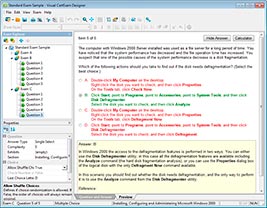
HOW TO OPEN VCEX FILES
Use ProfExam Simulator to open VCEX files
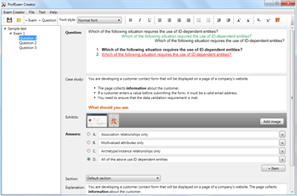
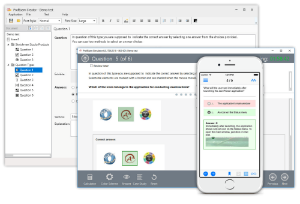
ProfExam at a 20% markdown
You have the opportunity to purchase ProfExam at a 20% reduced price
Get Now!